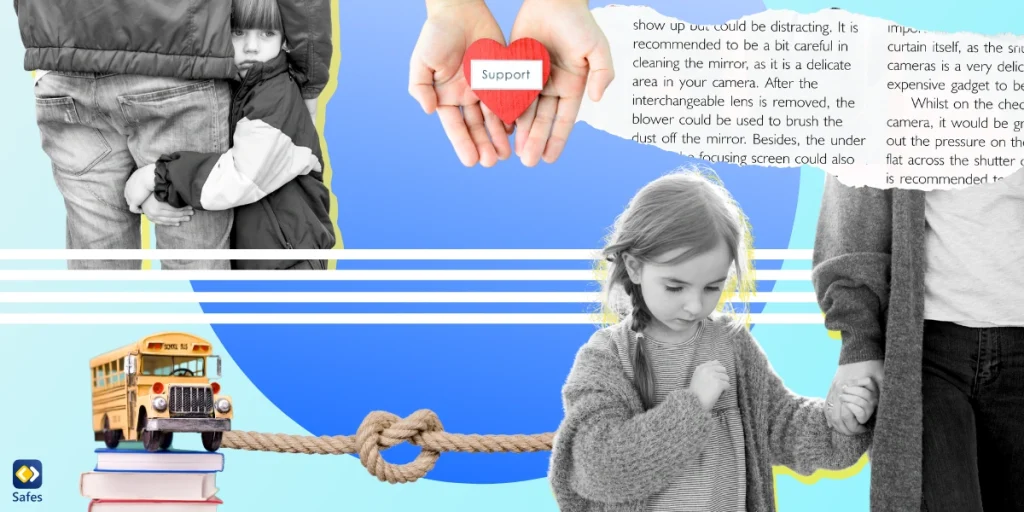Parenting is a complex and challenging journey. As parents, we all want to raise happy, healthy, and successful children. However, the way we approach parenting can have a significant impact on our children’s development and well-being. In this blog post, we will discuss the 4 types of parenting styles and how they make a difference in children’s lives. These 4 types of parenting styles are authoritative, authoritarian, permissive, and uninvolved parenting. Understanding these parenting styles is crucial for parents, as it helps them identify their own parenting style and make necessary adjustments for their children’s growth and development.
Download and Start Your Free Trial of the Safes Parental Control App

Authoritative Parenting
Authoritative parenting is a parenting style that involves setting high expectations for children while also being responsive and nurturing. Key characteristics of this parenting style include establishing clear rules and boundaries, providing reasons for rules, encouraging independence, and using positive reinforcement.
The benefits of authoritative parenting include raising self-reliant, confident children who have good social skills. However, drawbacks can include potential conflicts if children do not respect boundaries and could lead to overly high expectations for children.
Real-world examples of authoritative parenting include parents who set clear expectations for their children’s behavior while also providing emotional support and guidance. They encourage their children to make their own decisions but also provide guidance when needed.
Authoritarian Parenting
Authoritarian parenting is characterized by strict rules, high demands, and little to no emotional warmth or support. Parents who employ this style believe in absolute obedience and use punishment as a means of discipline. Critical characteristics of authoritarian parenting include a lack of flexibility, low levels of communication, and a focus on conformity.
One benefit of authoritarian parenting is that it can lead to well-behaved children who excel academically. However, drawbacks include low self-esteem, poor social skills, and a higher likelihood of mental health issues.
Real-world examples of authoritarian parenting include parents who use physical punishment as a means of discipline, demand perfection from their children, and have little to no tolerance for individuality or independent thinking. These parents often prioritize obedience over an emotional connection and may use fear as a means of control.
Permissive Parenting
A permissive parent, on the other hand, is one who allows their child(ren) more freedom than an authoritarian one. Permissive parenting is characterized by low demands and high levels of emotional warmth and support. Parents who employ this style tend to be lenient and avoid using punishment as a means of discipline, often allowing their children to make their own decisions. Critical characteristics of permissive parenting include a lack of structure, limited rules, and a focus on communication.
One benefit of permissive parenting is that it can lead to a solid emotional bond between parent and child. However, drawbacks include a lack of discipline, poor academic performance, and a higher likelihood of risky behavior.
Real-world examples of permissive parenting include parents who avoid setting boundaries or enforcing rules, regularly give in to their child’s demands, and prioritize their child’s happiness over discipline or structure. These parents may also avoid confronting their child’s negative behavior or may be hesitant to intervene in their child’s life decisions.
Uninvolved Parenting
Uninvolved parenting is a parenting style that involves little to no emotional involvement or responsiveness from parents toward their children’s needs. Key characteristics of this parenting style include a lack of attention, support, and guidance, low expectations, and few to no rules.
The benefits of uninvolved parenting can be challenging to identify, as this parenting style can have negative impacts on children’s social, emotional, and academic development, leading to long-term consequences. Drawbacks can include children who feel neglected, have low self-esteem, and struggle with forming healthy relationships.
Real-world examples of uninvolved parenting include parents who are physically present but emotionally unavailable to their children. They may neglect their children’s basic needs, fail to set expectations or boundaries, and offer little to no guidance or support.
Comparing and Contrasting Parenting Styles
There are many situations in which one style of parenting works better than another. It’s important to understand why some parenting styles work better than others and how you can choose the right one for your family. One way to do this is to compare and contrast your own parenting style with the parenting styles of others in your social or educational community. This video from the Sprouts channel compares different parenting styles:
Choosing the Right Parenting Style
When you have a better understanding of the differences between parenting styles and how they work in the real world, it will be easier to choose the right one for your family. When you are choosing the right parenting style for your family, there are a few things to keep in mind.
Choosing a parenting style that suits your child’s needs and personality is crucial for their overall development and well-being. Each child is unique and may require a different approach to parenting. Understanding your child’s temperament, strengths, and weaknesses can help you choose a parenting style that provides them with the necessary support and guidance.
To evaluate your own parenting style, it’s essential to reflect on your interactions with your child and assess whether your current approach is meeting their needs. You may also seek feedback from your child, partner, or other trusted individuals. If changes are necessary, consider implementing small adjustments over time and assess their impact.
Resources and support for parents who want to improve their parenting skills are widely available. These may include parenting classes, counseling services, support groups, and online resources such as blogs, forums, and podcasts. Seeking advice from trusted professionals or other experienced parents can also be helpful. It’s important to remember that parenting is a continuous learning process, and seeking support and guidance can help you become a more effective and confident parent.
Practical Strategies for Improving Your Parenting Style
When you are in the midst of adjusting to a new parenting style, you may feel like you are behind the 8-ball. Parenting is a constantly evolving challenge and requires adaptability, flexibility, and boldness.
Parents who are flexible and willing to change their parenting style when their child(ren) needs it will have a much easier time raising emotionally healthy, competent young people. Parents who are more inflexible and rigid in their ways suffer when trying to make changes. Either way, the ultimate goal is to adopt an authoritative parenting style.
Developing an authoritative parenting style requires setting clear boundaries, but also being responsive to your child’s needs. Be consistent in your rules and consequences, but also allow for flexibility and negotiation. To reduce authoritarian behaviors, avoid harsh punishments and instead focus on positive reinforcement and problem-solving. To reduce permissive behaviors, set clear expectations and hold your child accountable for their actions.
Self-care is essential for improving parenting skills as it allows you to recharge and approach parenting with a clear mind. Take time for yourself, practice self-compassion, and seek support when needed.
How Can Safes Help You Improve Your Parenting?
The Safes parental control app is designed to help parents monitor and manage their children’s online activities. With Safes, parents can set limits on screen time, block inappropriate content, and track their children’s location. By using this app, parents can have greater control over their children’s Internet usage and ensure that their children are staying safe online.
The app can also help parents improve their parenting by providing them with insights into their children’s online behavior, allowing them to identify potential issues and have conversations with their children about online safety.
Additionally, Safes can help parents build trust with their children, as they can work together to set boundaries and ensure that both parties feel comfortable with their online activity. Overall, the Safes parental control app can be an essential tool for parents who want to improve their parenting and keep their children safe online.
Safes is available both on Android and iOS devices. Download it from our website and benefit from a 14-day trial with premium features. To learn how to use Safes for your child’s benefit, follow the links below:
- Windows parental controls
- Macbook parental controls
- Parental controls on Android
- iPhone parental controls
Concluding the 4 Types of Parenting Styles
In this blog post, we discussed the 4 types of parenting styles and how they make a difference in children’s lives. We have discussed the differences between authoritative parenting, permissive parenting, and uninvolved parenting and how choosing the right style for your family can make a huge difference in the quality of your child’s life.
Your Child’s Online Safety Starts Here
Every parent today needs a solution to manage screen time and keep their child safe online.
Without the right tools, digital risks and excessive screen time can impact children's well-being. Safes helps parents set healthy boundaries, monitor activity, and protect kids from online dangers—all with an easy-to-use app.
Take control of your child’s digital world. Learn more about Safes or download the app to start your free trial today!




